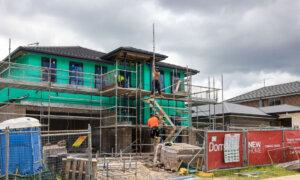Report Shows Almost Half of Young Australians Are Unsure About Achieving Home Ownership Amid Housing Crisis
Less than half of young Australians believe they will be able to purchase a property for themselves, according to the 2024 Australian Youth Barometer report released by Monash University on July 31.
The findings highlight a significant hopelessness among young people regarding home ownership.
“This lack of optimism was also reflected by interviewees, who believed that purchasing property would become increasingly difficult in the future,” the report states.
One interviewee shared, “I hope I get enough money to even think about buying a house one day because houses are just so expensive, and even the extra costs. I don’t really have an idea of a timeline in my mind because it’s just depressing; prices are just going up.”
Due to rising rental prices, the report found that more than 58 percent of young Australians surveyed live in their family home, 16 percent live in a house-sharing arrangement, 12 percent live independently, 14 percent live independently as a family or couple, and the remaining 1 percent live in other situations.
The survey included 623 participants aged 18–24.
In response to this crisis, MP Clare O’Neil, the newly appointed Minister for Housing and Homelessness, addressed the issue in a video on X (formerly Twitter), saying her government is committed to resolving the problem.
“For a whole generation of young people, there is a sense that the dream of home ownership is slipping away,” she said.
“This crisis has been a generation in the making, and we are going to try to do something about it. We are engaging in housing in a big way.”
She further noted that the last federal budget allocated more funds for housing than the entire nine years the coalition was in power.
“We are backing this in a big way, but I don’t want to underplay the scale of the task here,” she added.
“We have a serious problem on our hands, and my job is to ensure we get more homes for more Australians so that the dream of home ownership becomes a reality.”
The situation is even grimmer for Indigenous Australians, with 71 percent more likely to be living in the family home compared to other Australians.
Additionally, young people from high socioeconomic backgrounds also face similar living arrangements, while those in metropolitan areas are more likely to stay with their families than those in regional or remote areas.
Australia is currently grappling with a severe housing crisis characterised by soaring property prices and rental costs that are pushing many into financial distress.
Among young people, only 60 percent believe it is likely or very likely they will ever live in a comfortable home.
This outlook varies, with young men feeling more optimistic (63 percent) than young women (58 percent) or gender-diverse individuals (43 percent).
Young people without disabilities were also more hopeful about future housing conditions compared to those with disabilities or health conditions.
One interviewee in the report described their struggle: “I’m living in a shed, which also rings true to the rental prices. If I couldn’t even afford rent on the salary that I’m on now … I’m working full-time as a high school teacher, and I still live in a shed.”
Another interviewee reported living alone in one of the “poorest neighbourhoods,” stating, “I got really cheap rent. I’m really lucky, but the house has black mould and asbestos.”
Majority of Young Aussies Unsure About Future Housing Affordability
Further, the crisis is contributing to rising homelessness rates, particularly among vulnerable populations.
The report found that two-thirds (67 percent) of young Australians thought it likely or highly likely they would stay in their current accommodation over the next 12 months.
Compared with those born in other countries (48 percent), a higher proportion of young people born in Australia (71 percent) believed they would stay in their current accommodation over the next 12 months.
Less than one-third (31 percent) thought it likely or highly likely they would be able to afford a comfortable place to live in the next 12 months.
Supporting these findings, the most recent Household, Income and Labour Dynamics in Australia (HILDA) survey shows that 54 percent of young men and 47 percent of young women aged 18–29 lived with their parents in 2021, up from 47 percent of young men and 36 percent of young women in 2001.
Eight percent of young people aged 18–22 living with their families were required to contribute to family housing costs by paying for accommodation.
Young people living away from their families faced unsuitable living conditions, worry about rent increases or evictions, and have concerns about the safety of their housing.
Despite these challenges, homeownership remains an important goal for many, with 57 percent of those aged 13–28 identifying it as part of the Australian dream.
However, young people today are less likely than older generations to place importance on home ownership. They place more emphasis on attaining their dream life (71 percent) rather than owning their dream home (29 percent).
“This may be due to the perceived difficulty of home ownership,” the report from the HILDA survey notes, “with 84 percent of all Australians believing that it is more difficult for young Australians to purchase their own home. Around two-thirds of all Australians believed that young Australians would never be able to buy a home.”
Supporting these concerns, the latest census data reveals that around 28,200 young people aged 12–24 experienced homelessness on census night in 2021, accounting for 23 percent of the total homeless population.
This figure is likely underestimated, as the census data did not capture some types of homelessness common among young people, such as couch surfing.





